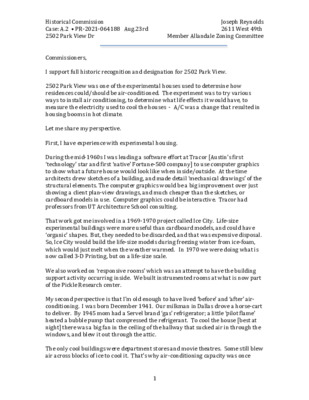A.2.g - 2502 Park View Dr - citizen comment — original pdf
Backup

Historical Commission Case: A.2 • PR-2021-064188 Aug.23rd 2502 Park View Dr Joseph Reynolds 2611 West 49th Member Allandale Zoning Committee Commissioners, I support full historic recognition and designation for 2502 Park View. 2502 Park View was one of the experimental houses used to determine how residences could/should be air-conditioned. The experiment was to try various ways to install air conditioning, to determine what life effects it would have, to measure the electricity used to cool the houses - A/C was a change that resulted in housing booms in hot climate. Let me share my perspective. First, I have experience with experimental housing. During the mid-1960s I was leading a software effort at Tracor [Austin’s first ‘technology’ star and first ‘native’ Fortune-500 company] to use computer graphics to show what a future house would look like when inside/outside. At the time architects drew sketches of a building, and made detail ‘mechanical drawings’ of the structural elements. The computer graphics would be a big improvement over just showing a client plan-view drawings, and much cheaper than the sketches, or cardboard models in use. Computer graphics could be interactive. Tracor had professors from UT Architecture School consulting. That work got me involved in a 1969-1970 project called Ice City. Life-size experimental buildings were more useful than cardboard models, and could have ‘organic’ shapes. But, they needed to be discarded, and that was expensive disposal. So, Ice City would build the life-size models during freezing winter from ice-foam, which would just melt when the weather warmed. In 1970 we were doing what is now called 3-D Printing, but on a life-size scale. We also worked on ‘responsive rooms’ which was an attempt to have the building support activity occurring inside. We built instrumented rooms at what is now part of the Pickle Research center. My second perspective is that I’m old enough to have lived ‘before’ and ‘after’ air- conditioning. I was born December 1941. Our milkman in Dallas drove a horse-cart to deliver. By 1945 mom had a Servel brand ‘gas’ refrigerator; a little ‘pilot flame’ heated a bubble pump that compressed the refrigerant. To cool the house [best at night] there was a big fan in the ceiling of the hallway that sucked air in through the windows, and blew it out through the attic. The only cool buildings were department stores and movie theatres. Some still blew air across blocks of ice to cool it. That’s why air-conditioning capacity was once 1 Joseph Reynolds 2611 West 49th Member Allandale Zoning Committee Historical Commission Case: A.2 • PR-2021-064188 Aug.23rd 2502 Park View Dr measured in ‘tons’ [or tons per hour]. The stores and theatres [like the Majestic and Palace in Dallas] used an ammonia refrigerant and water towers to cool it for condensing back to liquid. [Freon? There was no Freon.] What worked for Neiman Marcus and Sanger Bros. would not work for houses. My dad worked at the Magnolia Building in downtown Dallas [It had the “Flying Red Horse” on top.] when it was air-conditioned and they had to find ways to get air ducts through the masonry walls. Our current house on 49th St was built in 1951, and when we bought it in 1979 still had the floor-furnace for heat and had three window A/C to cool. I installed a fan in the ceiling of the hallway to replicate what I knew from childhood as a way to cool at night. The 1981 Memorial Day Flood got water in the crawl space under the house and killed the floor furnace. As a result of the flooding we couldn’t replace it, so the house got ‘central’ A/C. All the ‘How-To’ for domestic central air-conditioning was worked out in the different designs of The Air-Conditioned Village. The work confirmed that there would be a residential market, so technology was invented and improved. Freon did get developed. And, they didn’t “do an Ice-City” on the ‘experimental’ houses to make them disappear – families lived there and kept them. That’s what you’re being asked to preserve. The houses, their purpose, and their past are what you are asked preserve. They are Historical. These houses are icons of a past time. They are like cameras from 1860s, like working steam locomotives from 1880s, like preserved 1905 airplanes, like Edison recordings, like transistorized computers from late 1950s. Cameras, and locomotives, and airplanes, and recordings, and computers can be kept in museums. A village is its’ own museum, if you preserve it Do your duty, protect this group of houses that document the change that made the ‘new South’ possible, air conditioning and how to use it in residences. Thank You – Joe Reynolds Joe-rey@texas.net 2